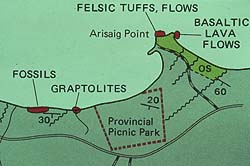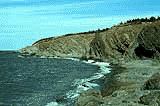| Arisaig Sea Cliffs
 Overlooking the warm waters of Nova
Scotia's Northumberland Strait, Arisaig offers a fascinating window to life on Earth
from 448 to 401 million years ago. One of North America's most continuously exposed
sections of Silurian rock is found here. The 4 kilometres (2.4 miles) of coastline from
McArras Brook to Arisaig Point, including Arisaig Provincial Park, exposes 47 million
years of earth history. This is not much in geological time - the Earth itself is older
than 4.5 billion years. Overlooking the warm waters of Nova
Scotia's Northumberland Strait, Arisaig offers a fascinating window to life on Earth
from 448 to 401 million years ago. One of North America's most continuously exposed
sections of Silurian rock is found here. The 4 kilometres (2.4 miles) of coastline from
McArras Brook to Arisaig Point, including Arisaig Provincial Park, exposes 47 million
years of earth history. This is not much in geological time - the Earth itself is older
than 4.5 billion years.
The rocks and fossils of Arisaig have been studied by geologists from around the world
for over 150 years. They represent a continuous record of conditions in a warm, shallow,
storm-frequented sea from the Late Ordovician Period
through the entire Silurian Period to the Early Devonian Period.
 From Arisaig Point southwestward to McArras Brook, thirteen rock units are
exposed in the cliffs with a total thickness of 1.6 km (1 mile). The oldest rocks are
found at Arisaig Point and consist of dark and light coloured lava and pyroclastic flows.
The sedimentary rocks of the Arisaig Group begin at the Point and continue toward McArras
Brook. Most of these rocks are siltstones and sandstones with uncommon shales. Almost all
show an abundance of fossils. From Arisaig Point southwestward to McArras Brook, thirteen rock units are
exposed in the cliffs with a total thickness of 1.6 km (1 mile). The oldest rocks are
found at Arisaig Point and consist of dark and light coloured lava and pyroclastic flows.
The sedimentary rocks of the Arisaig Group begin at the Point and continue toward McArras
Brook. Most of these rocks are siltstones and sandstones with uncommon shales. Almost all
show an abundance of fossils.
 |
 |
| Important Sites
Home |
Interpreting Arisaig's
Fossils |
|




 Overlooking the warm waters of Nova
Scotia's Northumberland Strait, Arisaig offers a fascinating window to life on Earth
from 448 to 401 million years ago. One of North America's most continuously exposed
sections of Silurian rock is found here. The 4 kilometres (2.4 miles) of coastline from
McArras Brook to Arisaig Point, including Arisaig Provincial Park, exposes 47 million
years of earth history. This is not much in geological time - the Earth itself is older
than 4.5 billion years.
Overlooking the warm waters of Nova
Scotia's Northumberland Strait, Arisaig offers a fascinating window to life on Earth
from 448 to 401 million years ago. One of North America's most continuously exposed
sections of Silurian rock is found here. The 4 kilometres (2.4 miles) of coastline from
McArras Brook to Arisaig Point, including Arisaig Provincial Park, exposes 47 million
years of earth history. This is not much in geological time - the Earth itself is older
than 4.5 billion years. From Arisaig Point southwestward to McArras Brook, thirteen rock units are
exposed in the cliffs with a total thickness of 1.6 km (1 mile). The oldest rocks are
found at Arisaig Point and consist of dark and light coloured lava and pyroclastic flows.
The sedimentary rocks of the Arisaig Group begin at the Point and continue toward McArras
Brook. Most of these rocks are siltstones and sandstones with uncommon shales. Almost all
show an abundance of fossils.
From Arisaig Point southwestward to McArras Brook, thirteen rock units are
exposed in the cliffs with a total thickness of 1.6 km (1 mile). The oldest rocks are
found at Arisaig Point and consist of dark and light coloured lava and pyroclastic flows.
The sedimentary rocks of the Arisaig Group begin at the Point and continue toward McArras
Brook. Most of these rocks are siltstones and sandstones with uncommon shales. Almost all
show an abundance of fossils. ![[Nova Scotia
Museum]](../../graphics/nsmlogo.gif)